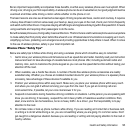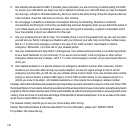Health and Safety Information 131
neuroma, tumors of the brain or salivary gland, leukemia, or other cancers. None of the studies demonstrated the
existence of any harmful health effects from wireless phone RF exposures. However, none of the studies can answer
questions about long-term exposures, since the average period of phone use in these studies was around three years.
11. What research is needed to decide whether RF exposure from wireless phones poses a health risk?
A combination of laboratory studies and epidemiological studies of people actually using wireless phones would provide
some of the data that are needed. Lifetime animal exposure studies could be completed in a few years. However, very
large numbers of animals would be needed to provide reliable proof of a cancer promoting effect if one exists.
Epidemiological studies can provide data that is directly applicable to human populations, but 10 or more years follow-
up may be needed to provide answers about some health effects, such as cancer. This is because the interval between
the time of exposure to a cancer-causing agent and the time tumors develop - if they do - may be many, many years.
The interpretation of epidemiological studies is hampered by difficulties in measuring actual RF exposure during day-
to-day use of wireless phones. Many factors affect this measurement, such as the angle at which the phone is held, or
which model of phone is used.
12. Which other federal agencies have responsibilities related to potential RF health effects?
Additional information on the safety of RF exposures from various sources can be obtained from the following
organizations.
•
FCC RF Safety Program:
–
http://www.fcc.gov/oet/rfsafety/
•
Environmental Protection Agency (EPA):
–
http://www.epa.gov/radiation/
•
Occupational Safety and Health Administration’s (OSHA):
–
http://www.osha-slc.gov/SLTC/radiofrequencyradiation/index.html
•
National Institute for Occupational Safety and Health (NIOSH):
–
http://www.cdc.gov/niosh/topics.emf
•
World health Organization (WHO):
–
http://www.who.int/peh-emf/en
•
International Commission on Non-Ionizing Radiation Protection:
–
http://www.icnirp.de
•
National Radiation Protection Board (UK):
–
http://www.hpa.org.uk/radiation


















